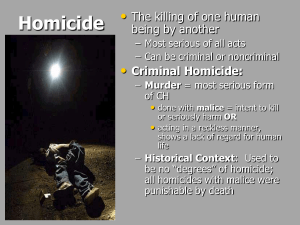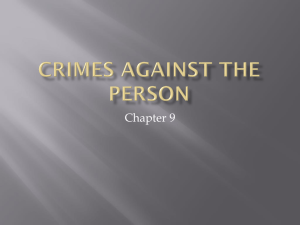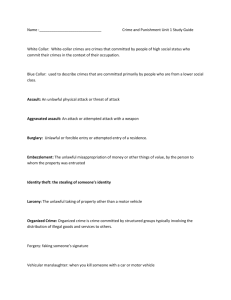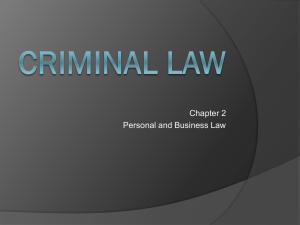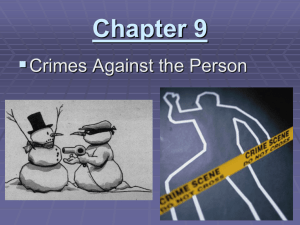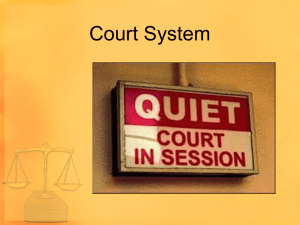CJ210: Unit 7
advertisement
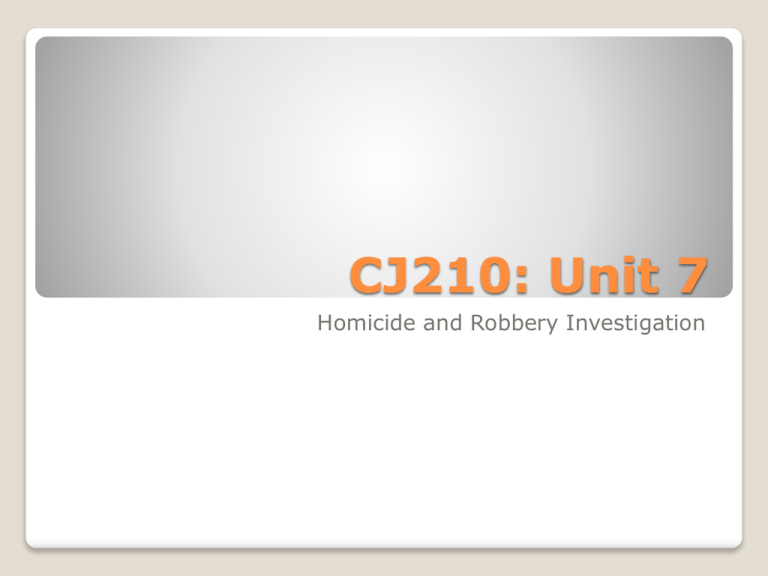
CJ210: Unit 7 Homicide and Robbery Investigation Any questions about anything before we begin? Missing assignments Unit 7: Seminar, Discussion, and Quiz Seminar: Homicides, manslaughter, crime scene assessment, victimology, and other. Tell me what homicide means to you? Unit 7 “Homicide is the killing of one human being by another. All homicides are not criminal: they may also be justifiable or excusable. (Self-inflicted death is treated by the police as homicide until it can be established as suicide.)” Do you know what criminal homicide is? Homicide “Criminal homicide is the unlawful taking of a human life. There are two kinds of criminal homicide: murder and manslaughter. “(page 351). What is the difference between murder and manslaughter? Let’s begin with murder first, then manslaughter. Criminal Homicide Murder Manslaughter “the unlawful killing of another human being with malice aforethought (premeditation). Killing a person during the commission of a felony also constitutes murder—even when the killing is unintentional. Most murder convictions are for felony murder rather than for premeditated murder.” “the unlawful killing of another without intent—expressed or implied—to effect death.” Note: Need to check individual state statutes also. Murder and Manslaughter Murder First degree Unlawful killing of a human being by another with malice aforethought, either express or implied Express malice: Actual intent to kill the person killed, or any other person Implied malice: Death results from intent to cause serious injury, or act creating great risk to others Intent to kill with deliberation and premeditation Felony-murder, during dangerous felonies Murder by poison, lying in wait, or torture Second degree: Killing with malice aforethought, but without deliberation and premeditation Felony-murder during felonies not inherently dangerous Murder (Criminal Law Guide) Felony-murder: Any death resulting from felony No intent to kill necessary, only intent to commit a felony Model Penal Code replaces rule with presumption of malice Manslaughter: Unlawful killing of a human being by another without malice aforethought Voluntary: Intentional killing without malice under mitigating circumstances Requires adequate provocation of the accused May include killing in the heat of passion before defendant cooled off Involuntary: Unintentional killing Commission of dangerous unlawful act Doing lawful act with criminal negligence Failure to perform legal duty showing criminal negligence Murder and Manslaughter Negligent homicide or vehicular homicide: Removes cases from manslaughter statute Usually involves operation of motor vehicle Corpus Delicti: “collection of basic facts establishing that a crime has been committed and that some person is responsible.” 1. The death was not the result of suicide, natural causes, or accident, thus establishing that it was a homicide. (This is the province of the forensic pathologist.) 2. Some person was responsible for the unlawful death. (Establishing the identity of the person is the province of the investigator, evidence technicians, and criminalists.) Circumstances will determine if murder or manslaughter Manslaughter and Corpus Delicti Investigative activities in a homicide and Responsibilities. (pages 353-355). In your opinion, what are some of the most common motives for homicides? Investigation and Good Information To Review Financial gain Sexual gratification Apparently sex-connected homicides Emotional factors Self-protection Removal of an inconvenience or impediment Apparently motiveless crimes “Thrill” killing (pages 355356) Crime Scene: center point and important questions Motives Is this an unlawful homicide? Is this a homicide disguised as a suicide? Who is the deceased? What was the motive for the killing? Is there physical evidence present that may link the killer to the crime scene or the victim or could be useful in reconstructing the crime? What happened and/or how was the crime committed? Page 364 Do you know what associative evidence is? Investigative Checklist Evidence that can link the perpetrator to the crime scene or victim is of two kinds: (1) evidence brought to and left (often unintentionally) at the scene; and (2) evidence taken deliberately or accidentally from the scene. Examples (1)- fingerprints; spent bullets and cartridge cases, and blood, hair, and fibers from the person or clothing of the perpetrator. (2)-easily carried items, small appliances; rug and clothing fibers; broken glass particles imbedded in clothing or in the rubber heel of a shoe; smeared fresh paint or blood spattered on clothing; and other. Sources of associative evidence Associative Evidence Traces of the person Finger and palm prints Blood, semen, saliva, hair Bare footprints Other skin patterns such as ear prints and lip impressions Teeth marks Traces of wearing apparel Shoe prints Weave pattern and stitching of clothing and gloves Clothing accessories Impressions left by Weapons—firearms, cutting or stabbing devices Tools—jimmies, metal cutters, hammers, metal punches Shovels—used to bury a body or weapon (Some types of soil, such as clay, retain striation marks left by the digging edge of a shovel.) Reconstructing the crime (FYI: pages367-380) Sources of Associative Evidence Criteria for ViCap Homicides: solved, unsolved, attempted (particularly if an abduction is involved); appear to be random, motiveless, or sexually oriented; suspected or known to be part of a series. Missing Persons: if the circumstances indicate a strong possibility of foul play and the victim remains missing. Unidentified Dead Bodies: if the manner of death is known or suspected to result from criminal homicide. Violent Criminal Apprehension Program (ViCAP) Does this photo tell us anything about the crime? Crime Scene That time once again Thanks for attending and I enjoyed the seminar and participation Reminder; missing assignments, complete unit 7 seminar, discussion, and quiz Need anything let me know and have a good week I will stay online to answer any questions Wrap Up
